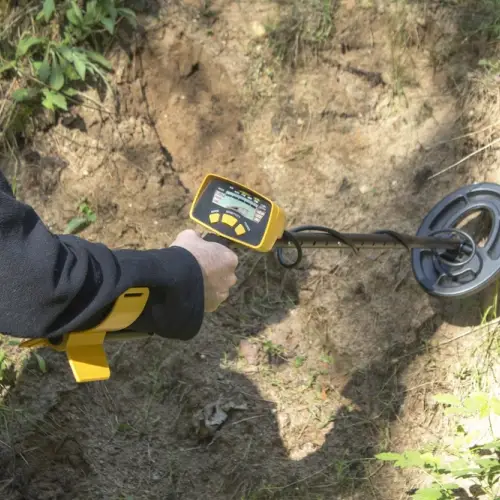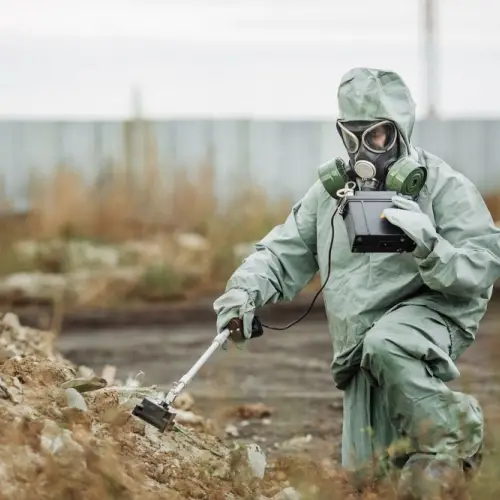Radioactivity measurement involves quantifying the emission of ionizing radiation from radioactive materials. It is performed using various instruments such as Geiger-Müller counters, dosimeters and radiation spectrometers. These devices detect and measure the amount of alpha, beta and gamma particles emitted by a radioactive source.
Measuring radioactivity is essential in many fields. For example, in nuclear safety, it ensures that nuclear power plants do not release dangerous levels of radiation. In medicine, it allows treatments such as radiotherapy to be administered precisely to target tumours without damaging healthy tissue. In industry, it is used to check the quality of welds or measure the thickness of materials. In science, it is used to date ancient fossils. Finally, in environmental protection, it can detect radioactive contamination and protect the population.
Difference between measurement units and radiation dose
 Radioactivity measurement units quantify radioactive activity, i.e. the number of nuclear decays occurring per second in a source. In contrast, radiation dose units measure the energy that radiation deposits in a material or tissue and consider the biological effects of this radiation.
Radioactivity measurement units quantify radioactive activity, i.e. the number of nuclear decays occurring per second in a source. In contrast, radiation dose units measure the energy that radiation deposits in a material or tissue and consider the biological effects of this radiation.
While the former focus on the amount of radiation emitted, the latter focus on the impact of that radiation in terms of absorbed energy and potential damage to health.
Units of measurement
 These units focus on measuring the radioactive activity of a source, that is, the number of nuclear decays that occur in one second.
These units focus on measuring the radioactive activity of a source, that is, the number of nuclear decays that occur in one second.
- Becquerel (Bq) : One becquerel equals one nuclear disintegration per second, which is known as typical activity. It is the International System (SI) unit for measuring radioactivity. For example, a sample of a radioactive material may have an activity of 500 Bq, meaning there are 500 disintegrations per second.
- Curie (Ci) : One curie equals 3.7 x 10^10 disintegrations per second. It is an older unit that is still used in some contexts, especially in the United States. 1 Ci = 37 GBq (gigabecquerel).
Radiation dose units
These units focus on measuring the energy that radiation deposits in a material or tissue and the biological effects of that radiation.
- Gray (Gy) : One gray is equivalent to the absorption of one joule of radiation energy per kilogram of matter. It is the SI unit for measuring absorbed radiation dose.
- Rad : One rad is equivalent to the absorption of 0.01 joules of radiation energy per kilogram of matter. It is an older unit, replaced by the gray in the SI. 1 Gy = 100 rad.
- Sievert (Sv) : A sievert measures the equivalent dose, which takes into account the biological effect of radiation. It is the SI unit for measuring radiological risk. For gamma and beta radiation, 1 Gy = 1 Sv, but for alpha radiation, 1 Gy may be equivalent to more than 1 Sv due to its greater biological effect.
- Rem : One rem equals the absorption of 0.01 sievert. It is an older unit that has been replaced by the sievert in the SI. 1 Sv = 100 rem.
This table shows several examples of radiation dose levels:
|
Type of radiation |
Dosis (Gy) |
Equivalent dose (Sv) |
|
Dental X-ray |
0.005 - 0.01 Gy |
0.005 - 0.01 Sv |
|
Chest X-ray |
0.1 Gy |
0.1 Sv |
|
TAC abdominal |
5 - 10 mGy (0.005 - 0.01 Gy) |
5 - 10 mSv (0.005 - 0.01 Sv) |
|
Daily radiotherapy |
1 - 2 Gy |
1 - 2 Sv |
|
Median lethal dose (LD50/30)* |
3.5 - 4.5 Gy |
3.5 - 4.5 Sv |
|
Nuclear accident (immediate) |
1,000 - 10,000 Gy (varies depending on proximity to the epicenter) |
1,000 - 10,000 Sv (varies depending on proximity to the epicenter) |
These values are approximate and may vary depending on the specific type of radiation, the type of tissue exposed and other factors, but they give us an idea of the difference in doses between the different elements of the table.
* The term "LD50/30" refers to a measure used in radiobiology and radiology to indicate the dose of ionizing radiation that is expected to cause the death of 50% of an exposed population within 30 days after exposure.
Devices for measuring radioactivity
 A radioactivity measuring device is an instrument designed to detect and quantify radiation emitted by radioactive materials. It uses physical principles such as gas ionization in Geiger-Müller counters, light emission in scintillation spectrometers, or electrical pulse generation in semiconductor detectors.
A radioactivity measuring device is an instrument designed to detect and quantify radiation emitted by radioactive materials. It uses physical principles such as gas ionization in Geiger-Müller counters, light emission in scintillation spectrometers, or electrical pulse generation in semiconductor detectors.
These devices are used to monitor radiation levels, assess risks and ensure compliance with safety regulations.
Here are the main types and their characteristics:
- Geiger-Müller (GM) counters: detect ionizing particles (alpha, beta, gamma) that ionize the gas inside the detector tube, producing an electrical discharge. They are common for measuring environmental radiation levels and in radiation protection and safety applications. They are simple and robust devices, and are ideal for detecting radiation in real time.
- Dosimeters: These measure the cumulative dose of radiation received by a person. They are designed for personal use (worn by workers exposed to radiation) and area use (monitoring radiation levels in specific spaces). They are used in work environments to ensure that the doses received do not exceed safe limits.
- Scintillation spectrometers: use scintillation crystals that emit light when excited by radiation. The light emitted is proportional to the energy of the radiation. They analyse the energy of gamma photons, allowing the identification of specific radioactive isotopes. Their main advantages are their high precision and ability to identify different types of radiation.
- Ionization Chambers: These measure the ionization of the air or gas within the chamber caused by radiation. They are used to measure radiation exposure in a specific volume, common in medical and environmental applications. They generally provide accurate measurements of absorbed dose.
- Semiconductor detectors: These use semiconductor materials that generate an electrical pulse when radiation passes through them. These detectors offer high precision in measuring ionizing radiation and are useful in radiation research and monitoring.